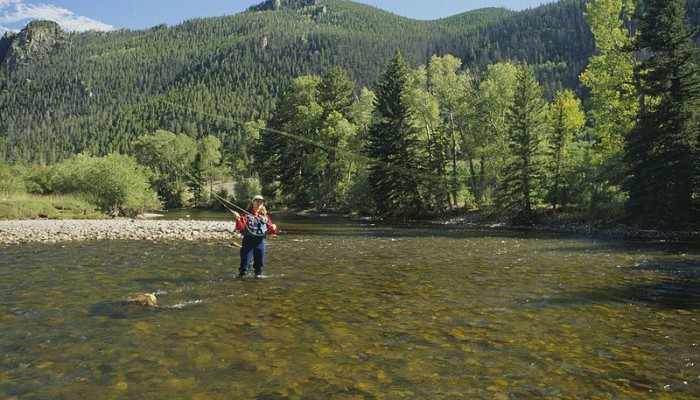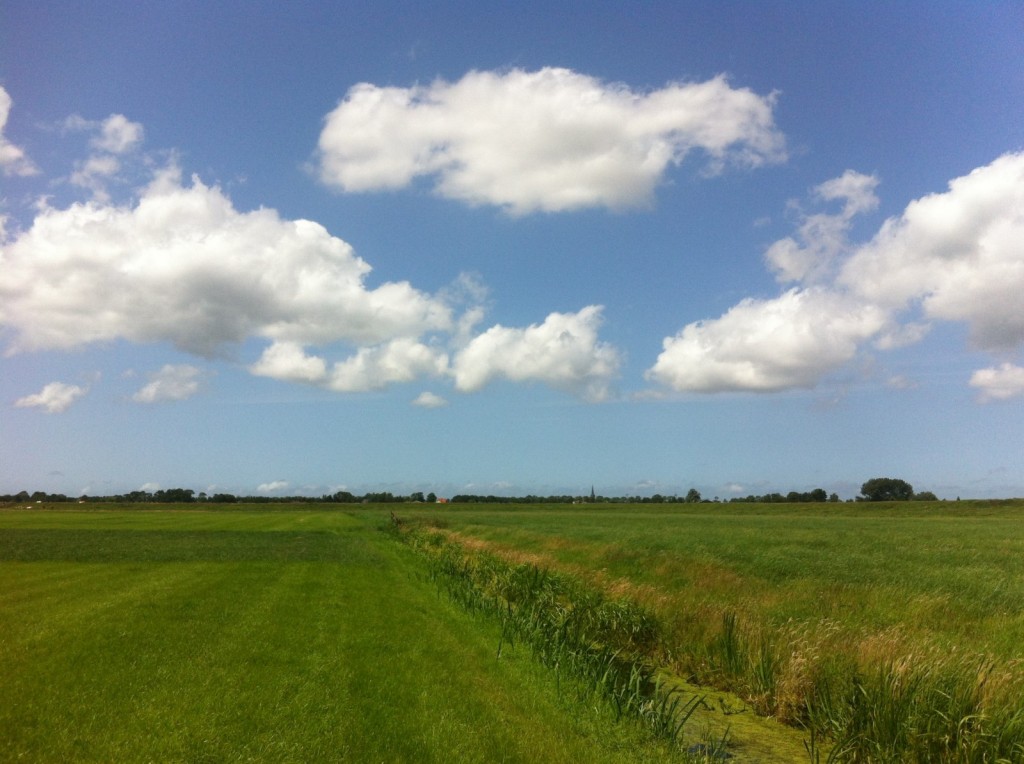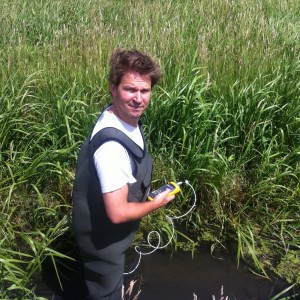
Dutch and American researchers have developed waders equipped with temperature sensors that enable fly-fishers to find the best fishing locations while collecting data to help scientists study streams. The research is published today (29 February) in Geoscientific Instrumentation Methods and Data Systems (GI), an open access journal of the European Geosciences Union. In this GeoTalk interview we talk to Rolf Hut, a hydrologist at the Delft University of Technology, and lead author of the paper, as well as with Tim van Emmerik, co-author of the paper and also a hydrologist at Delft University of Technology, to learn more about this unique invention and its application for both hydrologists and fly fishers!
What was the motivation behind this study? How did the idea to use temperature sensing waders for environmental sciences come about?
Rolf: The idea originated during a discussion between Scott Tyler and I at the 2014 AGU Fall Meeting . We were discussing the difficulty in calibrating DTS (Distributed Temperature Sensing, see Selker et al., 2006) in streambeds and suddenly the thought popped in our heads that we are wearing waders when installing DTS cables, why not equip the waders with temperature sensors? When we started to further think this idea through (beer may have been involved), we realised that fly-fishers walking in streams with temperature sensing waders would make a great source of data for scientists studying hyporheic exchange (the study of groundwater-streamwater interaction).
Furthermore, fly fishers themselves could benefit from knowing local stream temperature to find optimal fishing locations. Therefore, we set out to, as a first test, prove that temperature sensing waders could potentially provide this information. The result of that test is presented in our current paper.
What data do you hope to collect with your waders and what applications, both for the scientific community and the wider public, would the data have?
Rolf: As scientists, we hope these data help us better understand where groundwater enters streams and where stream water drains away to the groundwater. Hyporheic exchange (groundwater-streamwater interaction) is a complex field of study, with very local places where groundwater enters small streams. Understanding this is vital in understanding stream-water ecology: which species live where in the stream. Ultimately, good understanding of stream dynamics helps us advise policies that better balance multiple use of stream water: as a natural habitat for plants and animals, and as a human drinking resource and place for recreation.
However, measurements of streamflow dynamics, including stream temperature, are usually labour intensive and at the same time, stream dynamics vary highly between different streams. For better understanding, more measurements are needed, but scientists are (rightly so) budget constrained in this. Therefore, we believe our temperature sensing waders, when applied at large scale, can be very beneficial to our understanding of stream dynamics.
Tim: In just the USA alone, an estimated 27 million recreational anglers regularly fish in freshwater streams and lakes. Imagine if they were all equipped with a temperature sensing wader! This would mean a constant supply of new, accurate data, which can be used to estimate water quality and quantity, fish ‘hotspots’, and overall state of the ecosystem.
How did you show your idea of using waders and smartphones to measure water temperature was feasibility?
Rolf: In this paper we only wanted to test whether a sensor in the bottom of a wader would be able to detect (large) differences in stream temperature so we could pinpoint locations of groundwater-streamwater interaction.
We tested this in two ways. First, we tested it in the field by walking in a stream where we knew a localised influx of cold groundwater was present. I was wearing the waders and also used a reference thermometer to measure water temperature. Secondly, we tested how long it takes for the waders to change temperature when exposed to a drop, or rise, in temperature. We tested this in the Water Lab of Delft University of Technology by preheating the waders and then exposing it to the colder water of the flume in our lab. We differed the flow velocity in the flume, and also tested what the influence of having a (warm blooded) human leg in the wader was to the temperature it sensed.
Could you clarify what advances you’ve made since you first presented this research at the EGU General Assembly last April?
Rolf: After the initial idea, I submitted an abstract to the General Assembly. In the abstract for the GA I merely promised to “show a prototype”. Because of other academic deadlines, and my own chaotic mind, this meant that the prototype demonstrated at the General Assembly was made the Sunday before the GA started, in our AirBnB apartment in Vienna. My poster had an explanation of “the idea” in it, and my phone showed the real-time temperature of the wader. I had to calibrate it on the spot, so I needed both a hot and a cold reference temperature. We used the ice intended for the beers during the poster session as cold calibration. If people are still wondering why the beer was not as cold as it should have been that day: now they know. Hooray for last minute science :-s. However, walking around in waders during the poster session drew the attention of journalist who covered our work. Which was, honestly, at that point at a very early stage. For the work presented in this paper, we took the time to be more precise and did a proper calibration in our lab.
Tim: The presentation at EGU got a lot of enthusiastic reactions, from scientists, professionals, journalists, and many others. We used the momentum that was gained at the GA to very effectively do our lab measurements, fieldwork campaign at a beautiful Dutch windmill-filled site, and wrap up the study in a concise paper.

Location in the Dutch country side where researchers tested their prototype waders. Credit: Tim van Emmerik
Do you have any plans to actively engage the fishing community and get members of the public to use the waders?
Rolf: Now that we have demonstrated first feasibility we want to discus with producers of waders to find the best way to easily incorporate sensors in many waders. Once that is sorted out, we want to reach out to communities with interest, such as (fly-)fishing groups, local conservation groups and schools. After the press coverage that the GA sparked, several of these groups already reached out to us. I have kept that at arm’s length for now, because we wanted to be sure that the ideal would hold up to a first test, which we now have demonstrated.
In your view, what are the most important results and implications of this study?
Rolf: it works!
Basically, we had a wild idea at the AGU Fall Meeting and demonstrated a prototype at the EGU General Assembly. We now have demonstrated that this prototype is capable of measuring the type of temperature changes we are interested in. With that hurdle taken, the road to citizen science campaigns is now open.
Tim: This work really is an example of how relatively simple measurement devices can be fused with existing equipment to actively involve communities in gathering scientific data. It’s becoming a trend to find ways to incorporate ‘alternative’ communities in science. Whether it’s school kids or fishermen, studies like ours demonstrate that everyone can be a scientist.
For more information about the research published in Geoscientific Instrumentation Methods and Data Systems (GI) you can read the associated press release issued today to accompany the publication. You’ll also find the open-access paper by following this link.




Pingback: Temperatuur metende waadbroek: nu ook wetenschappelijk gepubliceerd